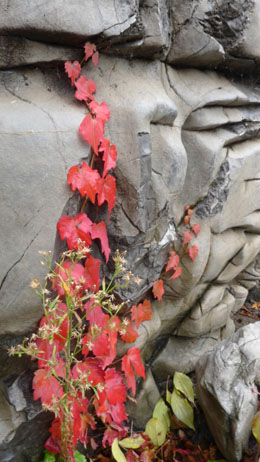The Virginia creeper is from the Vitaceae family and is also referred to as the 'five-leaved ivy, among other names. Let's find out more about this kind of vine, in the following facts.

Scientifically known as Parthenocissus quinquefolia, the Virginia creeper vine is native to the United States, and belongs to the woody vine family. In the wild, this perennial vine reaches a staggering height of 20-30 m. Smooth surfaces are fancied by this creeper, climbing with the help of its small forked tendrils. The leaves consist of five (in some cases, three) leaflets, 3-20 cm in length. The production of fruit and seeds take place in the spring and continue until fall. Propagation can be done with the help of its bare root, a container, and seeds.
Facts about the Virginia Creeper Vine
- The advantage of growing this vine is its compatibility with a variety of soil types ranging from dry sandy soil, to moist loamy soil. However, it does best in acidic soil.
- For light requirements, partial shade to full sun is preferred by the plant.
- Also, the plant happens to be salt-tolerant. It can be planted next to seashores and roadsides.
- The vine is even drought-tolerant. However, watering it every week and soaking the soil at a depth of six inches, adds to the health of the creeper.
- Fall or spring is considered a suitable time to sow the seeds. Also, the seeds must be planted at a depth of 3/8 inches.
- Common places where this vine can be found include forests margins, on trees, fence-rows, stream banks, and roadsides.
- It is during late spring or fall when the flowers of this plant mature into berries, which are purplish-black in color.
- Thanks to the thick foliage produced by the vine, it provides for small animals, shelter.
- When planted in shaded areas and on slopes, the vine actually helps in preventing soil erosion.
- From a medicinal point of view, the bark of the vine becomes of great use in treating coughs, where the berries can be used for various rheumatic complaints. The roots are used as a remedy for diarrhea.
- Because of its deep burgundy foliage in the fall, the plant is popularly used as an ornamental plant. The vine can be used to transform uninteresting walls, trellises, masonry walls, arbors, or fences, into things of beauty.
- The vine does well as a shady medium for buildings, keeping a place cooler during the summers, thus, reducing the cost on air conditioning.
- Some people may not appreciate the aggressive growth rate of this plant, and may wish to get rid of it. The best way to do this is to cut the vine's trunk. Never try to rip the plant from the surface, or it'll cause damage to what it's growing on. Apply an appropriate kind of Roundup, a herbicide, to the freshly-cut stumps. With time, the vine should lose its grip on the wall, or whatever surface it's growing on.
- The sap of the plant contains what is known as oxalate crystals. These agents, upon contact with the skin, can cause an irritation that leads to a skin rash. However, not all may experience this reaction.
- Be careful when choosing where you want to plant this creeper; if other plants or trees are in its vicinity, it can take hold and not allow them to absorb nutrients from the sun or the soil.






 Scientifically known as Parthenocissus quinquefolia, the Virginia creeper vine is native to the United States, and belongs to the woody vine family. In the wild, this perennial vine reaches a staggering height of 20-30 m. Smooth surfaces are fancied by this creeper, climbing with the help of its small forked tendrils. The leaves consist of five (in some cases, three) leaflets, 3-20 cm in length. The production of fruit and seeds take place in the spring and continue until fall. Propagation can be done with the help of its bare root, a container, and seeds.
Scientifically known as Parthenocissus quinquefolia, the Virginia creeper vine is native to the United States, and belongs to the woody vine family. In the wild, this perennial vine reaches a staggering height of 20-30 m. Smooth surfaces are fancied by this creeper, climbing with the help of its small forked tendrils. The leaves consist of five (in some cases, three) leaflets, 3-20 cm in length. The production of fruit and seeds take place in the spring and continue until fall. Propagation can be done with the help of its bare root, a container, and seeds.